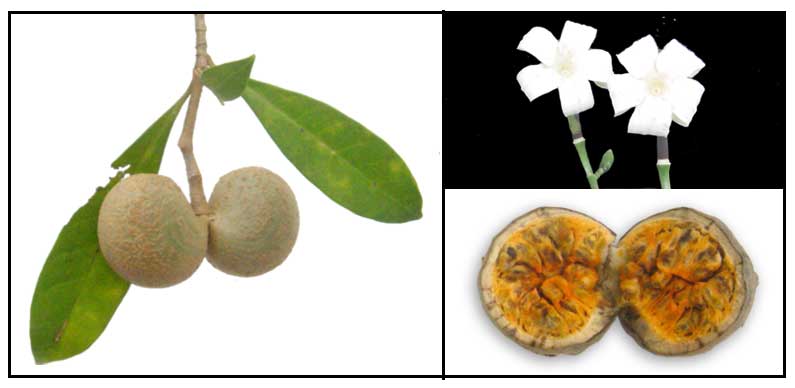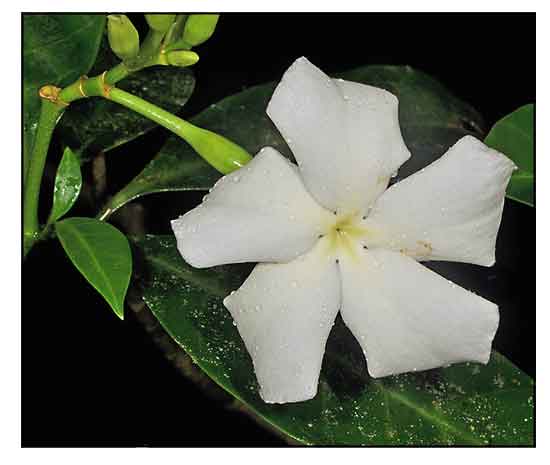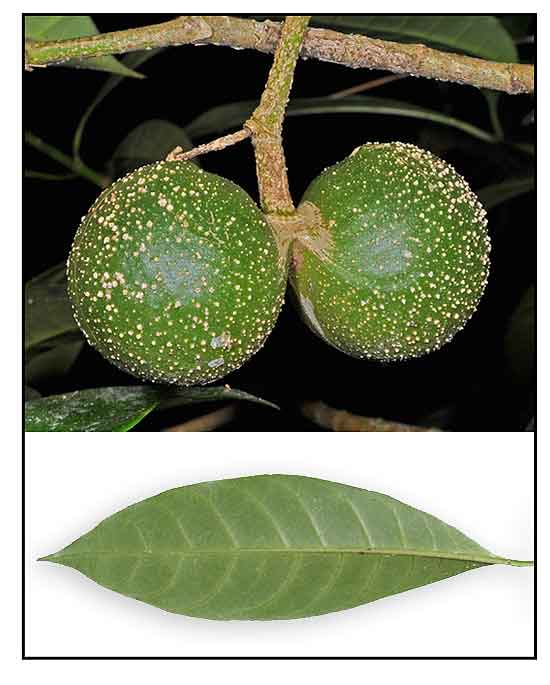| 
Gen info
• Voacanga is a genus of plants in the family Apocynaceae found in Afica, Southeast Asia, New Guinea, and Australia.
• As of 2013, the World Checklist of Selected Plant Families lists 13 species. Four are found in the Philippines: Voacanga foetida, V. globosa, V. grandifolia, and V. megacarpa. (17)
• Etymology: The genus was described in 1806 by Du Petit Thouars, who named it for the Madagascan words voa, meaning "fruit", and acanga, meaning "guinea fowl", referring to the spotted fruits. (22)
• The genus was described independently by Blume in 1826 as Orchipeda as O. foetida from Java. The genus and species epithets traveled a taxonomic journey until Rolfe (1883) reduced the last genus name tp a synonym of Voacanga, and since then all later taxa have been described directly as species of Voacanga. (22)
Botany
• Bayag-usa is a tree reaching a height of up to 3 meters.
Leaves are simple, opposite, oblong-elliptic; dark green in the upper
surface and pale beneath. Flowers are creamy white and showy. Fruit
comes in pairs, brownish, 3 to 5 centimeters in diameter. Seeds are embedded
in the pulp.
 Distribution Distribution
- Endemic to the Philippines.
- In secondary forests and
thickets at lower elevations.
- Sometimes ornamentally cultivated for its flowers.
Constituents
- Study identified a bisindole alkaloid from V. grandifolia, Voacinol, assigned a 14,14'-methylene-bis-18-hydroxytabersonine structure on the basis of spectral data. (21)
-
Preliminary phytochemical screening of leaves yielded alkaloids, saponins, 2-deoxysugars, and hydrolyzable tannins. (see study below) (10)
- A bioassay-guided purification yielded
Globospiramine (1), a new spirobisindole alkaloid possessing an Aspidosperma-Aspidosperma skeleton, together with deoxyvobtusine (2), deoxyvobtusine lactone (3), vobtusine lactone (4) and lupeol (5). (see study below) (11)
 Properties Properties
- Studies have suggested anticancer, anti-mitotic, antimycobacterial, immunosuppressive, immunostimulatory, anticholinesterase properties.
Parts used
- Fruits, leaves.
Uses
Folkloric
- In Bataan, used in the treatment of ulcers, wounds, and tumors. (9)
- Fruit used as antidote for food poisoning. (8)
- The Ati tribe of Iloilo apply the paste of fresh leaves to the forehead to treat fever and spasmodic pains.
- For relapse (pasma): Leaves are heated over low flame and patient is made to sit on some of the leaves while other leaves are pasted on the stomach. (16)
- Decoction of plant used for treatment of hernia and cancer.
- In Mindanao, the B'laan tribe in Mount Matutum use decoction (part not specified) for treatment of cancer and hernia. (18)
Others
- Pounded fruits used to stupefy eels. (6)
Studies
• Anti-cancer:
A study reports nine of 35 tree species tested had positive anticancer
activity. Voacanga globosa was added to the list of trees with anticancer
substances based on a report on actual remission and inhibition of induced
cell division.
• Alkaloids / Tabernaemontanine:
Studies on the alkaloids of Voacanga globosa (Blanco) Merrill
Isolated and characterized tabernaemontanin.
• Anticancer: Study of medicinal plants in the Philippines lists nine of 35 tree species to possess anticancer activity, including Voacanga globosa, with anticancer substances based on remission and inhibition of induced cell division.
• Anti-Colon Cancer / Apoptosis: Study evaluated the cytotoxic and pro-apoptotic activity of fractions of leaves on HCT116 human colon carcinoma and A549 human lung carcinoma cell lines. Results showed the MP3 fraction exerted cytotoxic activity on HCT116 cells via induction of apoptosis triggered by loss of mitochondrial membrane potential crucial for cell survival.
(9)
• Antibacterial / Antifungal / Antiprotozoal / Leaves: Study evaluated ethanol extracts of leaves of Voacanga globosa for cytotoxicity and for activity against bacteria, fungus, and protozoa.
Results showed antibacterial activity against Staph aureus, Bacillus cereus, P. aeruginosa, Micrococcus luteus, and Salmonella typhimurium; antifungal assay showed inhibition of Candida albicans; antiprotozoal assay showed activity against Trichomonas vaginalis and Entamoeba histolytica. (10)
• Antimycobacterial / Anticholinesterase: Bioassay-guided
purification yielded globospiramine, a new spirobisindole alkaloid, together with deoxyvobtusine, deoxyvobtusine lactone, vobtusine lactone, and lupeol. Globospiramine exhibited potent antituberculosis activity against Mycobacterium tuberculosis H(37)Rv. The bisondole alkaloids also showed promising anticholinesterase activity. (see constituents above) (11)
• Cytotoxicity Screening of Alkaloids / Leaves: Study evaluated the cytotoxic activity of alkaloids from T. pandacaqui and Voacanga globosa leaves using Brine Shrimp Lethality Assay.
The alkaloid content of the extracts were quantified as milligrams of Vincristine Sulfate Equivalent (mg VSE) using Bromocresol Green Assay. VG yielded an alkaloid content of 105.3 mg VSE translating to a yield of 0.527%, with a LC50 value of 40.8 ppm. Results warrant further investigation for cytotoxic action with potential use in cancer chemotherapy. (12)
• Biphasic Inflammatory Response / Leaves: Study evaluated four concentrations of ethanolic leaf extracts administered intraperitoneally in mice. The ethanolic leaf extract exhibited biphasic inflammatory effects—immunostimulatory at low concentrations and immunosuppressive at high concentrations. (14)
• Cytotoxic and Antimitotic Alkaloids / Leaves: Study evaluated the cytotoxic and antimitotic effects of the semi-purification of alkaloids from V. globosa leaves extract. Percent survival ± standard deviation of Brine Shrimp Lethality Assay showed 1000 ppm concentration has highest cytotoxic effect with the computed LC50 of 187.1429. On Alium Test, the 1000 ppm showed the highest antimitotic effect with computed EC50 of 555.6667. Therefore, the higher the concentration, the higher the activity. (15)
• Cytotoxic / Antiproliferative / Pro-Apoptotic / Spirobisindole Alkaloids: Study evaluated the cytotoxic and antiproliferative activities of spirobisindole alkaloids from V. globosa, including pro-apoptotic activity of the most potent alkaloid. Previous isolated alkaloids globospiramine (1), deoxyvobtusine (2) and vobtusine lactone (3) were subjected to invitro MTT assay. Alkaloids 1-3 showed cytotoxicity and antiproliferative activities against tested cell lines viz.,
L929, KB3.1, A431, MCF-7, A549, PC-3, and SKOV-3. Globospiramine (1)
was the most biologically active. Western blot analysis showed compound 1 promoted increased expression of cleaved caspase-3 and PARP, indicating the treated cancer cells underwent caspase-dependent apoptosis. Results demonstrated the anticancer potentials of the spirobisindole alkaloids, especially globospiramine (1) with its proapoptotic activity. (19)
• Potential against SARS-CoV-2: Computational screening methods and intricate selection of putative viral protein targets identified lead mitigating compounds against COVID-19. Antitubercular products offer starting points as potential antagonistic prospects for SARS-CoV-2 non-structural proteins involved in viral replication and infection mechanisms. Deoxyvobtusine lactone (6), deoxyvobtusine (7), and multi-targeting globospiramine (3) – antitubercular bisindole alkaloids previously isolated from Voacanga globosa – were noted as top drug-like candidates against SARS-CoV-2 based on the combined analysis of their binding affinities, drug-likeness properties, and probability of success in clinical trials. Study demonstrates, for the first time, computational screening of antitubercular compounds against three important targets of SARS-CoV-2 yielding potential drug-like compounds for COVID-19 treatment. (20)
Availability
Wildcrafted. |




 Properties
Properties

